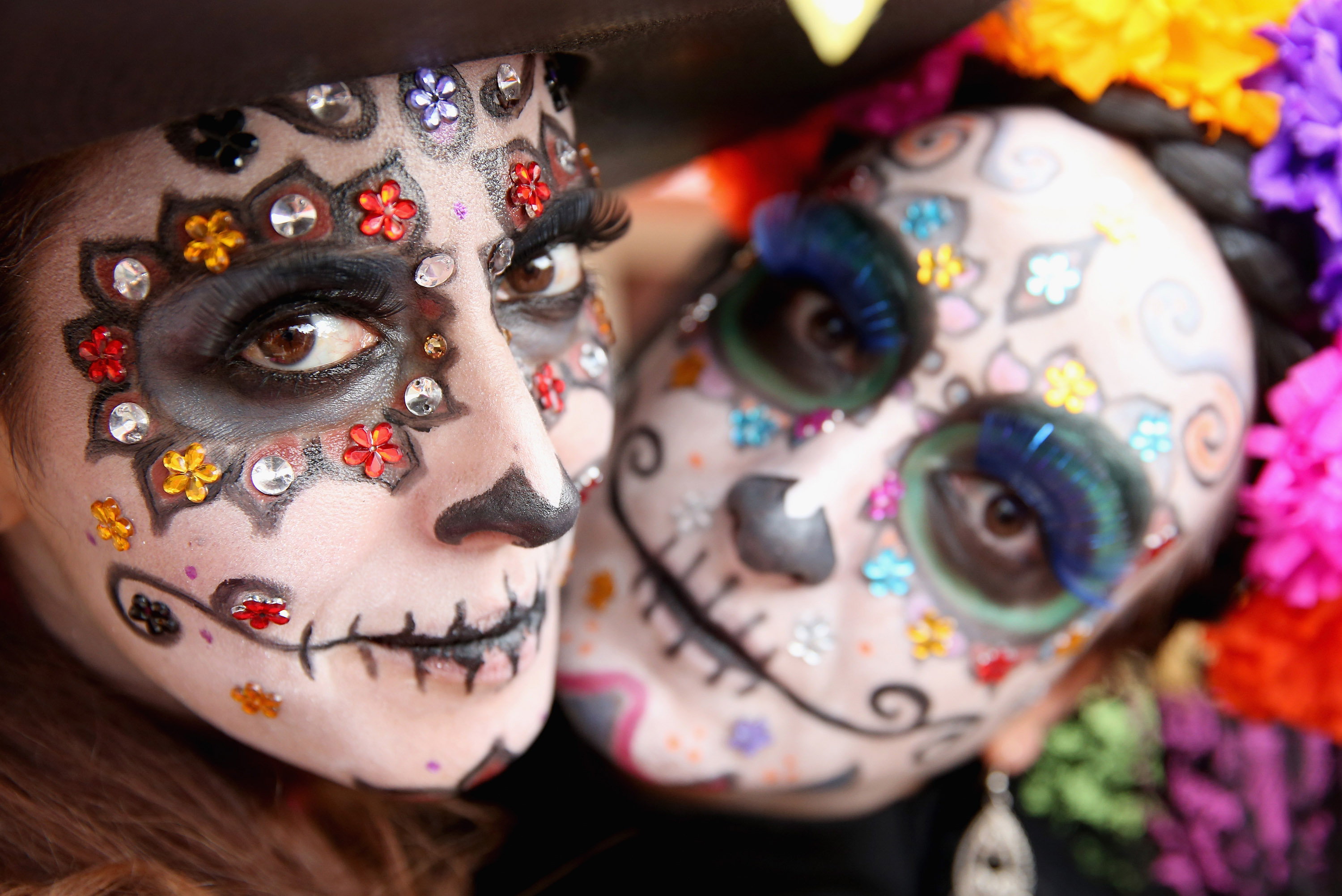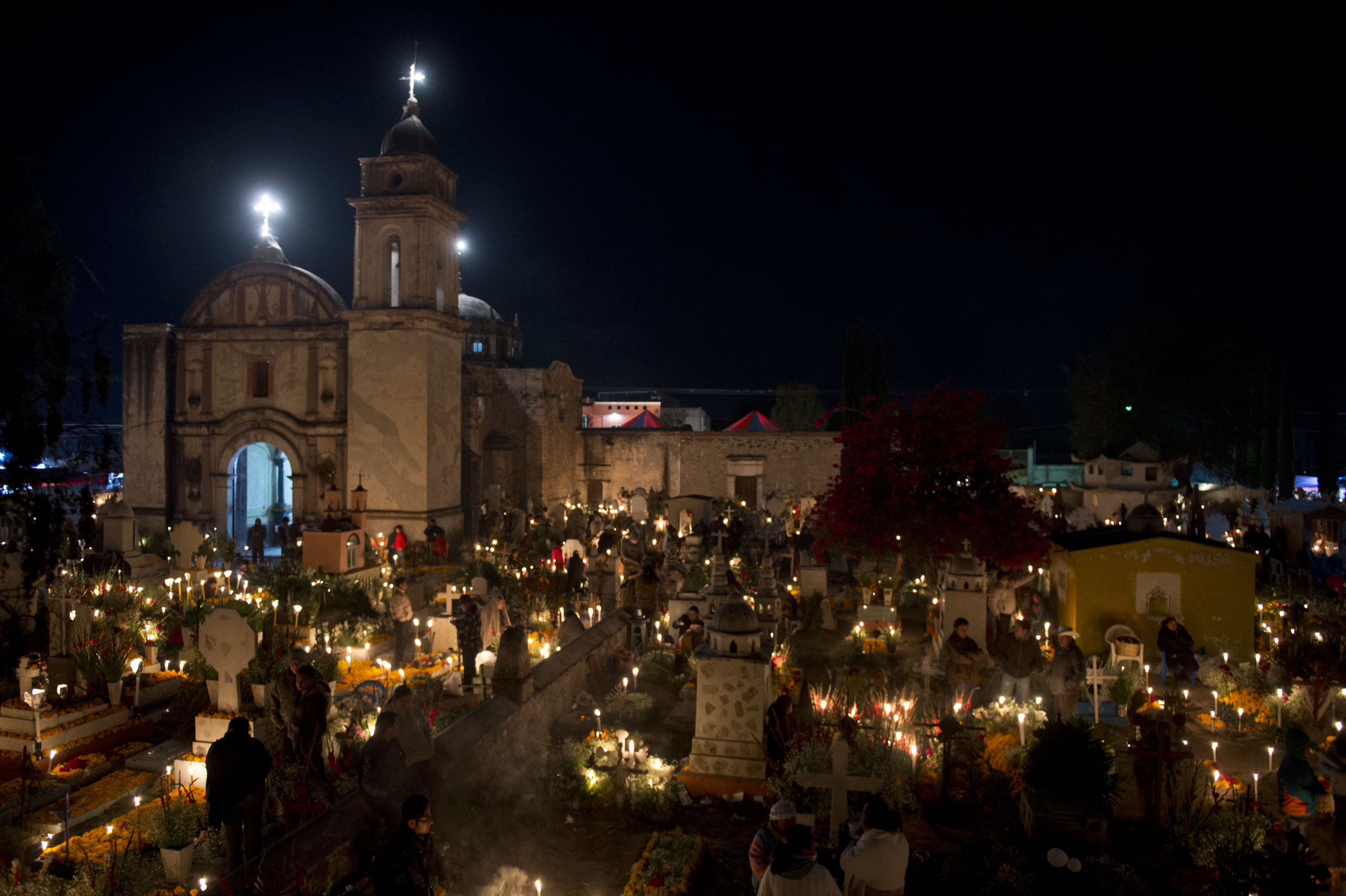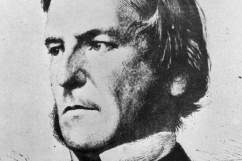The Mexican holiday Dia de los Muertos, or Day of the Dead, is being celebrated on November 2 with a Google Doodle.
“Its name is decidedly somber, but Mexico’s celebration of its departed souls overflows with color, music, and the unmistakable fragrances of its wonderful cuisine,” the Google Doodle team says. “To honor this holiday of mourning and remembrance, artist Kevin Laughlin has reimagined our logo as a string of papel picado, the vibrant, artfully perforated tissue paper that will drape windowsills and doorways all over Mexico tonight. Here’s to lively festivals and fond memories. ¡Salud y felicidad!”
Here’s what you need to know about the Day of the Dead:
1. The Holiday Is a Celebration of the Lives of Those Who Have Passed Away

Girls in facepaint in Real del Monte on the ‘Day of the Dead’ on November 2, 2014 in Hidalgo, Mexico.(Getty)
Dia de los Muertos, or Day of the Dead, is celebrated on November 2. The holiday is included in the days of the dead, along with Halloween and All Saint’s Day. It is also often connected with the Catholic holiday of All Soul’s Day.
“The days of the dead are truly a celebration of life,” according to a University of New Mexico website about the holiday. “When children dance with caricatures of death, eat skull sugar molds and learn to respect that life is brief, they learn there is a circle to life and to not fear death and then are free to enjoy and appreciate every moment.”
2. People Wear Skull Masks, Dance & Eat ‘Sugar Skulls’
Those celebrating the holiday in Mexico wear skull masks, which are called calacas and dance to honor their deceased relatives, according to the Arizona Republic.
They also make sugar skulls, with the name of a deceased relative on the forehead, which are then eaten by a friend or family member, according to the newspaper.
According to National Geographic, “Assured that the dead would be insulted by mourning or sadness, Dia de los Muertos celebrates the lives of the deceased with food, drink, parties, and activities the dead enjoyed in life. Dia de los Muertos recognizes death as a natural part of the human experience, a continuum with birth, childhood, and growing up to become a contributing member of the community. On Dia de los Muertos, the dead are also a part of the community, awakened from their eternal sleep to share celebrations with their loved ones.”
3. Day of the Dead Has Been Celebrated in Mexico for At Least 3,000 Years

A couple disguised as dead poses at San Jeronimo Chicahualco cemetery in Metepec, Mexico on November 2, 2013 during the commemoration of the Day of the Dead. (Getty)
The Day of the Dead tradition is rooted in Mexican culture and has been celebrated for thousands of years. It was first a part of the Aztec culture, but became mixed with Christian beliefs when the Spaniards came to Mexico, according to the Arizona Republic:
Unlike the Spaniards, who viewed death as the end of life, the natives viewed it as the continuation of life. Instead of fearing death, they embraced it. To them, life was a dream and only in death did they become truly awake. However, the Spaniards considered the ritual to be sacrilegious. They perceived the indigenous people to be barbaric and pagan.
In their attempts to convert them to Catholicism, the Spaniards tried to kill the ritual. But like the old Aztec spirits, the ritual refused to die. To make the ritual more Christian, the Spaniards moved it so it coincided with All Saints’ Day and All Souls’ Day (Nov. 1 and 2), which is when it is celebrated today.
According to the National Endowment for the Humanities, “The Aztec Festival of the Dead was originally a two-month celebration during which the fall harvest was celebrated, and figures of
‘death’ were personified as well as honored. The festival was presided over by Mictecacíhuatl, Goddess of the Dead and the Underworld, also known to the Aztecs as Mictlán. In the pre-Columbian belief system, Mictlán was not dark or macabre, but rather a peaceful realm where souls rested until the days of visiting the living, or los Días de los Muertos, arrived. Over the course of the festivities, participants place offerings for the dead in front of homemade altars, including special foods, traditional flowers, candles, photographs, and other offerings.”
4. Families Traditionally Visit the Gravesites of Their Loved Ones on Day of the Dead

People visit a cemetery in Tlacotepec, Puebla State, Mexico on November 2, 2012 during the commemoration of Mexico’s Day of the Dead. (Getty)
Families in Mexico “invite” their deceased relatives to return to the home for a visit on Day of the Dead, by placing photographs of their loved ones on altars, and offering flowers to them, according to the national Endowment for the Humanities.
“Extended families will often gather in cemeteries on the eve of November 2nd, el Día de los Muertos, and congregate at the gravesite of a deceased loved one to hold a commemorative feast. The family may keep a night-long vigil by eating the foods they have made in preparation for the celebration, visiting with each other, and praying for all the members of the extended family, both living and dead,” the NEH website says.
5. The Holiday Is Also Celebrated in Parts of the United States & Latin America
The Day of the Dead holiday is also celebrated in the United States, especially in cities with large populations of people with Mexican ancestry, and parts of Latin America.
Families often build altars in their homes to dedicate to their deceased loved ones, surrounding them with flowers, food and pictures. They also light candles next to the altars. According to the Associated Press, Day of the Dead celebrations are growing across the U.S. Major celebrations are held each year in Texas, New Mexico, California and many other areas.
Versions of the holiday are also celebrated in Bolivia, Brazil, Ecuador and Guatemala.


